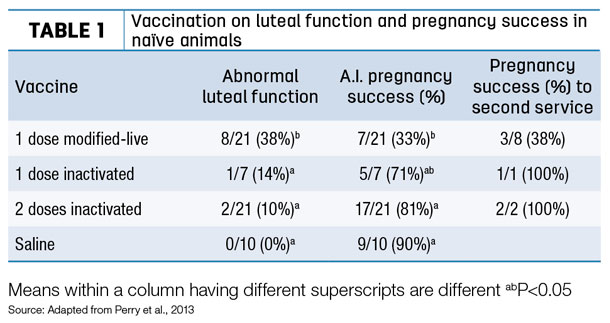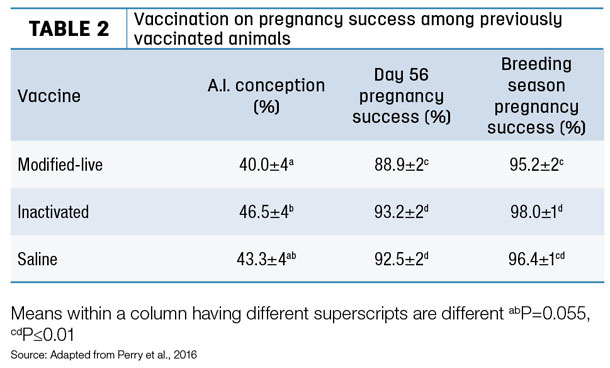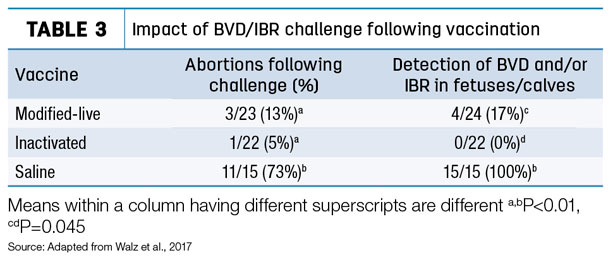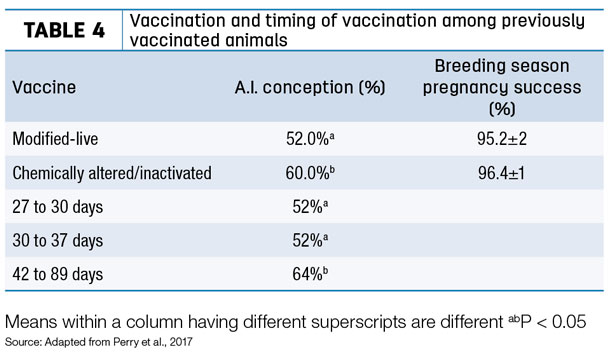A recent study investigated the effect of vaccinating naïve heifers with either a modified-live vaccine or inactivated virus vaccine at the start of a fixed-time A.I. synchronization protocol.

In this study, no control heifers (non-vaccinated) experienced abnormal estrous cycles, but heifers vaccinated with one dose of a modified-live vaccine (at start of synchronization protocol) had significantly more (38 percent) abnormal estrous cycles compared to control heifers.
Both controls and heifers vaccinated with two doses of inactivated vaccine had greater pregnancy rates compared to heifers vaccinated with one dose of modified-live.
 Bulls were with heifers for only 14 days following A.I.; thus, heifers only had one chance to conceive unless they experienced an abnormal estrous cycle. Of heifers that experienced an abnormal estrous cycle, 100 percent of heifers vaccinated with an inactivated vaccine conceived during the return cycle, but only 38 percent of heifers vaccinated with a modified-live vaccine conceived.
Bulls were with heifers for only 14 days following A.I.; thus, heifers only had one chance to conceive unless they experienced an abnormal estrous cycle. Of heifers that experienced an abnormal estrous cycle, 100 percent of heifers vaccinated with an inactivated vaccine conceived during the return cycle, but only 38 percent of heifers vaccinated with a modified-live vaccine conceived.
Thus, even when utilizing a synchronization protocol that induces ovulation at the start of the protocol, negative reproductive effects were seen when vaccinating naïve heifers with a modified-live vaccine. These negative effects occurred not only on the first service but also on the second service following vaccination.
 The negative effects of abnormal luteal function that occur following vaccination of naïve animals with a modified-live vaccine have not been reported in heifers previously vaccinated.
The negative effects of abnormal luteal function that occur following vaccination of naïve animals with a modified-live vaccine have not been reported in heifers previously vaccinated.
Two studies using small numbers of heifers vaccinated pre-breeding with either a modified-live, inactivated vaccine or saline showed 15 percent to 20 percent greater pregnancy success in heifers vaccinated with inactivated vaccine or saline compared to those vaccinated with the modified-live vaccine.
 Since numbers in these studies were small, subsequent work was designed to examine differences in pregnancy success between well-vaccinated beef females vaccinated with either a modified-live or an inactivated vaccine 30 days before the breeding season, with sufficient power to detect small differences in pregnancy success (nine herds with 1,436 animals).
Since numbers in these studies were small, subsequent work was designed to examine differences in pregnancy success between well-vaccinated beef females vaccinated with either a modified-live or an inactivated vaccine 30 days before the breeding season, with sufficient power to detect small differences in pregnancy success (nine herds with 1,436 animals).
Conception rates to fixed-time A.I. tended to differ between modified-live-treated animals and inactivated treated animals; control animals were intermediate. Day 56 conception rates (A.I. plus one return estrus) were greater in the inactivated group compared to the modified-live group. Animals in the modified-live group had decreased pregnancy success compared to the saline group.
It is commonly thought inactivated vaccines provide a lower level of protection against viruses than do modified-live vaccines.
However, a recent study reported heifers vaccinated with a modified-live prior to their first breeding season and then vaccinated with a chemically altered/inactivated vaccine before their second breeding season had similar levels of protection against abortions following both a bovine viral diarrhea and infectious bovine rhinotracheitis challenge as animals vaccinated with a modified-live vaccine.
Therefore, a field study was conducted to examine differences in pregnancy success between well-vaccinated beef females vaccinated with either a modified-live vaccine or a chemically altered/inactivated vaccine between 27 and 89 days before the breeding season (10 herds with 1,565 animals).
Conception rates to A.I. were greater in the chemically altered/inactivated vaccine group compared to the modified-live vaccine group.
Furthermore, animals vaccinated 27 to 30 days pre-breeding and animals vaccinated 30 to 37 days pre-breeding had similar conception rates; however, both were decreased compared to animals vaccinated 42 to 89 days pre-breeding. There was no treatment by interval interaction, indicating at all three intervals conception rates to the chemically altered/inactivated vaccine were increased compared to the modified-live vaccine.
So where do these studies leave us on the impact of virus vaccines on reproductive success? Vaccines against infectious reproductive diseases are valuable tools in the prevention of these diseases, as outbreaks of these diseases can be potentially devastating to a beef herd. This work also highlights the importance of proper vaccination of females before they enter the breeding herd.
However, evidence is growing that modified-live versions of these vaccines can have negative effects on reproductive management in well-managed herds.
Studies utilizing different pre-breeding vaccination protocols and intervals indicate modified-live vaccines, even when given at 30 days pre-breeding, may negatively affect reproductive parameters compared to cattle vaccinated with chemically altered or inactivated vaccines.
In light of this research, it appears the choice of pre-breeding vaccine product type and timing is one to carefully consider. Important to this consideration is the level of exposure any given herd may have, as these large pre-breeding studies were not carried out in the face of a disease challenge.
.Future research will help determine how to strike the best balance between appropriate disease protection and minimizing harmful effects from vaccines themselves.
It is reasonable to expect striking this balance will be different for each individual operation, making it imperative producers consult their veterinarian and weigh all available information when making decisions about pre-breeding vaccinations in their herds. ![]()
Russell F. Daly is the extension veterinarian and a professor in the veterinary and biomedical sciences department at South Dakota State University and state public health veterinarian for the South Dakota Department of Health.

-
George A. Perry
- Beef Reproduction Management
- South Dakota State University
- Email George A. Perry






